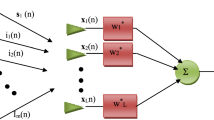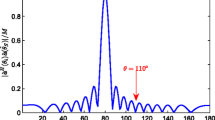Abstract
A minimum-disturbance description of adaptive beamforming algorithms opens up the derivation of novel methods for linearly constrained settings. Under this context, this paper proposes two algorithms, the IPCNLMS and the IPCNLMS-\(\ell _{0}\), and discusses their application for adaptive beamforming using a uniform rectangular array. These algorithms combine both proportionate and norm constraint strategies that are inserted in the traditional CNLMS algorithm in a smooth and rigorous way. The idea of jointly implementing CNLMS and IPNLMS algorithms is used to achieve faster convergence and the ability to attenuate interfering signals from multiple directions while using adaptive beamforming. The IPCNLMS updates each filter coefficient independently by adjusting the adaptation step size proportionally to the magnitude of the estimated filter coefficient. It is based on the \(\ell _{1}\)-norm penalty to exploit the convergence speed of the system. To take this idea further, the \(\ell _{0}\)-norm penalty is also considered in the IPCNLMS-\(\ell _{0}\) proposition. Simulations demonstrate that the proposed algorithms present faster convergence, under equivalent conditions of asymptotic performance, even when more realistic coupling effects between the array elements are taken into account. Beam pattern results show that the proposed algorithms are capable of achieving the optimum solution from LCMV as well as the CNLMS.









Similar content being viewed by others
Data Availability Statement
The datasets generated during and/or analyzed during the current study are available from the corresponding author on reasonable request.
References
Y. Ahn, J. Kim, S. Kim, K. Shim, J. Kim, S. Kim, B. Shim, Towards intelligent millimeter and terahertz communication for 6G: computer vision-aided beamforming. IEEE Wirel. Commun. (2022)
J.A. Apolinario, S. Werner, P.S.R. Diniz, T.I. Laakso, Constrained normalized adaptive filters for CDMA mobile communications. In: 9th European Signal Processing Conference (EUSIPCO 1998), pp. 1–4 (1998)
C.A. Balanis, Antenna Theory: Analysis and Design, 4th edn. (Wiley-Blackwell, Hoboken, NJ, 2016)
J. Benesty, S.L. Gay, An improved PNLMS algorithm. In: 2002 IEEE International Conference on Acoustics, Speech, and Signal Processing, vol. 2, pp. II–1881–II–1884 (2002). https://doi.org/10.1109/ICASSP.2002.5744994
F.T. Castoldi, M.L.R. de Campos, Application of a minimum-disturbance description to constrained adaptive filters. IEEE Signal Process. Lett. 20(12), 1215–1218 (2013). https://doi.org/10.1109/LSP.2013.2284384
M.L.R. de Campos, S. Werner, J.A. Apolinário, Constrained Adaptive Filters, pp. 46–64. Springer Berlin Heidelberg, Berlin, Heidelberg (2004). https://doi.org/10.1007/978-3-662-05592-2_3
J.V.G. de Souza, D.B. Haddad, F.D.R. Henriques, M.R. Petraglia, Novel proportionate adaptive filters with coefficient vector reusing. Circuits, Syst. Signal Process. 39(5), 2473–2488 (2019). https://doi.org/10.1007/s00034-019-01266-z
K.L. Du, M.N.S. Swamy, Z.Q. Wang, W.H. Mow, Matrix factorization techniques in machine learning, signal processing, and statistics. Mathematics (2023). https://doi.org/10.3390/math11122674
O. Frost, An algorithm for linearly constrained adaptive array processing. Proc. IEEE 60(8), 926–935 (1972). https://doi.org/10.1109/PROC.1972.8817
Q. Ge, Y. Zhang, Z. Feng, X. Liu, Novel robust adaptive beamformer in the presence of gain-phase errors. Circuits, Syst. Signal Process. 40, 1926–1947 (2021)
Y. Gu, J. Jin, S. Mei, \(\ell _{0}\)-norm constraint LMS algorithm for sparse system identification. IEEE Signal Process. Lett. 16(9), 774–777 (2009). https://doi.org/10.1109/LSP.2009.2024736
P. Ioannides, C. Balanis, Uniform circular and rectangular arrays for adaptive beamforming applications. IEEE Antennas Wirel. Propag. Lett. 4, 351–354 (2005). https://doi.org/10.1109/LAWP.2005.857039
V.S.N. Junior, M.P. Tcheou, M.H.C. Dias, D.B. Haddad, Constrained least mean square algorithm with coefficient reusing. Circuits, Syst. Signal Process. 40(11), 5705–5717 (2021). https://doi.org/10.1007/s00034-021-01721-w
M.V.S. Lima, G.S. Chaves, T.N. Ferreira, P.S.R. Diniz, Do proportionate algorithms exploit sparsity? (2021). https://doi.org/10.48550/ARXIV.2108.06846. ArXiv: arXiv:2108.06846
R.J. Mailloux, Phased Array Antenna Handbook, 3rd edn. (Artech house, Boston, MA, 2017)
C. Paleologu, J. Benesty, S. Ciochina, An improved proportionate NLMS algorithm based on the \(\ell _{0}\) norm. In: 2010 IEEE International Conference on Acoustics, Speech and Signal Processing, pp. 309–312 (2010). https://doi.org/10.1109/ICASSP.2010.5495903
N. Ruan, H. Wang, F. Wen, J. Shi, DOA estimation in B5G/6G: trends and challenges. Sensors (2022). https://doi.org/10.3390/s22145125
W. Shi, Y. Li, L. Zhao, X. Liu, Controllable sparse antenna array for adaptive beamforming. IEEE Access 7, 6412–6423 (2019). https://doi.org/10.1109/ACCESS.2018.2889877
H.L. Van Trees, Optimum Array Processing. Detection, Estimation, and Modulation Theory (John Wiley & Sons, New York, NY, 2002)
A. Voors, 4NEC2-NEC based antenna modeler and optimizer (2009). http://home.ict.nl/~arivoors/
T. Wild, V. Braun, H. Viswanathan, Joint design of communication and sensing for beyond 5G and 6G systems. IEEE Access 9, 30845–30857 (2021). https://doi.org/10.1109/ACCESS.2021.3059488
P. Zhang, Z. Yang, G. Jing, T. Ma, Adaptive beamforming via desired signal robust removal for interference-plus-noise covariance matrix reconstruction. Circuits, Syst. Signal Process. 40, 401–417 (2021)
Acknowledgements
This work was partially supported by Conselho Nacional de Desenvolvimento Científico e Tecnológico (CNPq), by Coordenação de Aperfeiçoamento de Pessoal de Nível Superior Brasil (CAPES) Finance Code 001 and by Fundação Carlos Chagas Filho de Amparo à Pesquisa do Estado do Rio de Janeiro (FAPERJ).
Author information
Authors and Affiliations
Corresponding author
Ethics declarations
Conflict of interest
The authors declare no conflicts of interest.
Additional information
Publisher's Note
Springer Nature remains neutral with regard to jurisdictional claims in published maps and institutional affiliations.
Rights and permissions
Springer Nature or its licensor (e.g. a society or other partner) holds exclusive rights to this article under a publishing agreement with the author(s) or other rightsholder(s); author self-archiving of the accepted manuscript version of this article is solely governed by the terms of such publishing agreement and applicable law.
About this article
Cite this article
Vieitos, M.d.S., Tcheou, M.P., Haddad, D.B. et al. Improved Proportionate Constrained Normalized Least Mean Square for Adaptive Beamforming. Circuits Syst Signal Process 42, 7651–7665 (2023). https://doi.org/10.1007/s00034-023-02459-3
Received:
Revised:
Accepted:
Published:
Issue Date:
DOI: https://doi.org/10.1007/s00034-023-02459-3




